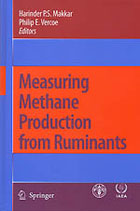The major limitation to ruminant production in many tropical regions of Africa, Asia and Latin America, where a large proportion of the global ruminant population is located, is poor nutrition. The productivity of animals is restricted by the low nitrogen and high fibre content of the native grasses and crop residues, which form the basis of the diets in these regions.
Measuring Methane Production from Ruminants
Book
Edited by Harinder P.S. Makkar and Philip E. Vercoe. Springer Publishers.
The world's livestock sector is amidst a major transformation, fuelled by high demand for meat and milk, which is likely to double over the next decades in developing countries. The major driving force behind this demand for livestock products is a combination of population growth, urbanization and income growth, especially in developing countries. The challenge is to enhance animal productivity without adversely affecting the environment. A key to this is reducing methane emissions from ruminants.

